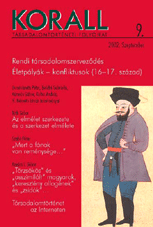Polgár vagy nemes? A városok nemesi rendű lakosainak problematikája a felső-magyarországi városszövetség tevékenysége tükrében
Bourgeois or noble? The problem of noble-rank city inhabitants – as mirrored by the activity of the Upper-Hungarian city union
Author(s): István H. NémethSubject(s): History
Published by: KORALL Társadalomtörténeti Egyesület
Keywords: social history; urban society; 17th century; Hungary; Felvidék (now Slovakia); noble people vs. bourgeoisie
Summary/Abstract: Noble inhabitants of cities make up two groups: those who acquired nobility as city bourgeois (noble bourgeois) and those nobles who, by diverse means, gained possession of houses of the city (city bourgeois). The status of the city bourgeois in free royal cities was always questionable and their presence a constant source of conflict. Although during the 16th century a law was successfully introduced to formulate the local taxation of city nobles, the influence of the county still grew within cities. Moreover, noble house possession went along with much heavier consequences for free royal cities, for these belonged not under the city’s but under royal reversionary jurisdiction. Counties, on the other hand, were not successful in controlling the noble bourgeoisie – an in-between situation some of its members attempted to profit from. However, in their attempts the noble bourgeois rather protected their own interests instead of – hypothetically – denying their bourgeois identity and turning against their cities. Towards the end of the century, counties in some cases succeeded in imposing tax on the noble bourgeois and even obliged them to rise during Rákóczi’s War of Independence (1703-1711). The noble bourgeois, however, generally acknowledged the city and not the county as a responsible authority. All in all, it would be mistaken to think that if a bourgeois gained noble rank, he would give up his bourgeois activity.
Journal: Korall - Társadalomtörténeti folyóirat
- Issue Year: 2002
- Issue No: 9
- Page Range: 79-106
- Page Count: 28
- Language: Hungarian

